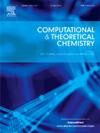Study of D–π–A coumarin bridge architectures for application as dyes in DSSC
IF 3
3区 化学
Q3 CHEMISTRY, PHYSICAL
引用次数: 0
Abstract
In this study, the molecular structures of twenty coumarin dyes were analyzed using first-principles calculations based on density functional theory. Geometry optimizations were performed for each molecular compound at the B3LYP/6-31G* and M06/cc-pVTZ levels of theory in gas phase. The electronic density, HOMO-LUMO energies, infrared spectrum, and chemical descriptors, such as electronegativity, chemical potential, and dipole moments, were examined from a combined theoretical-computational perspective. It was found that amine functional groups act as more effective electron donors than methyl groups, whereas the electron-accepting moiety must contain either carboxylic acid or cyano groups. Additionally, the presence of a dipole moment vector induces charge separation within the molecule, and molecular planarity influences electron delocalization. The dipole moment vector should originate from the coumarin bridge and extend toward the electron-donating group, establishing a charge transfer axis from the donor to the acceptor through the coumarin core.

D -π-A香豆素桥结构在DSSC染料中的应用研究
本研究采用基于密度泛函理论的第一性原理计算,分析了二十种香豆素染料的分子结构。在气相的 B3LYP/6-31G* 和 M06/cc-pVTZ 理论水平上对每种分子化合物进行了几何优化。从理论和计算相结合的角度考察了电子密度、HOMO-LUMO 能量、红外光谱以及电负性、化学势和偶极矩等化学描述指标。研究发现,胺官能团是比甲基更有效的电子供体,而电子受体必须包含羧酸或氰基。此外,偶极矩矢量的存在会导致分子内的电荷分离,而分子的平面性会影响电子析出。偶极矩矢量应源于香豆素桥,并向电子给体基团延伸,从而通过香豆素核心建立起从给体到受体的电荷转移轴。
本文章由计算机程序翻译,如有差异,请以英文原文为准。
求助全文
约1分钟内获得全文
求助全文
来源期刊

Computational and Theoretical Chemistry
CHEMISTRY, PHYSICAL-
CiteScore
4.20
自引率
10.70%
发文量
331
审稿时长
31 days
期刊介绍:
Computational and Theoretical Chemistry publishes high quality, original reports of significance in computational and theoretical chemistry including those that deal with problems of structure, properties, energetics, weak interactions, reaction mechanisms, catalysis, and reaction rates involving atoms, molecules, clusters, surfaces, and bulk matter.
 求助内容:
求助内容: 应助结果提醒方式:
应助结果提醒方式:


